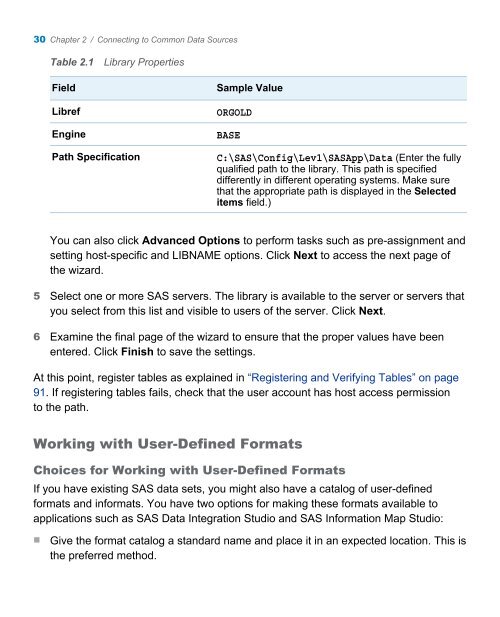SAS 9.3 Intelligence Platform: Data Administration Guide, Second ...
SAS 9.3 Intelligence Platform: Data Administration Guide, Second ...
SAS 9.3 Intelligence Platform: Data Administration Guide, Second ...
You also want an ePaper? Increase the reach of your titles
YUMPU automatically turns print PDFs into web optimized ePapers that Google loves.
30 Chapter 2 / Connecting to Common <strong>Data</strong> Sources<br />
Table 2.1 Library Properties<br />
Field Sample Value<br />
Libref ORGOLD<br />
Engine BASE<br />
Path Specification C:\<strong>SAS</strong>\Config\Lev1\<strong>SAS</strong>App\<strong>Data</strong> (Enter the fully<br />
qualified path to the library. This path is specified<br />
differently in different operating systems. Make sure<br />
that the appropriate path is displayed in the Selected<br />
items field.)<br />
You can also click Advanced Options to perform tasks such as pre-assignment and<br />
setting host-specific and LIBNAME options. Click Next to access the next page of<br />
the wizard.<br />
5 Select one or more <strong>SAS</strong> servers. The library is available to the server or servers that<br />
you select from this list and visible to users of the server. Click Next.<br />
6 Examine the final page of the wizard to ensure that the proper values have been<br />
entered. Click Finish to save the settings.<br />
At this point, register tables as explained in “Registering and Verifying Tables” on page<br />
91. If registering tables fails, check that the user account has host access permission<br />
to the path.<br />
Working with User-Defined Formats<br />
Choices for Working with User-Defined Formats<br />
If you have existing <strong>SAS</strong> data sets, you might also have a catalog of user-defined<br />
formats and informats. You have two options for making these formats available to<br />
applications such as <strong>SAS</strong> <strong>Data</strong> Integration Studio and <strong>SAS</strong> Information Map Studio:<br />
n Give the format catalog a standard name and place it in an expected location. This is<br />
the preferred method.

















